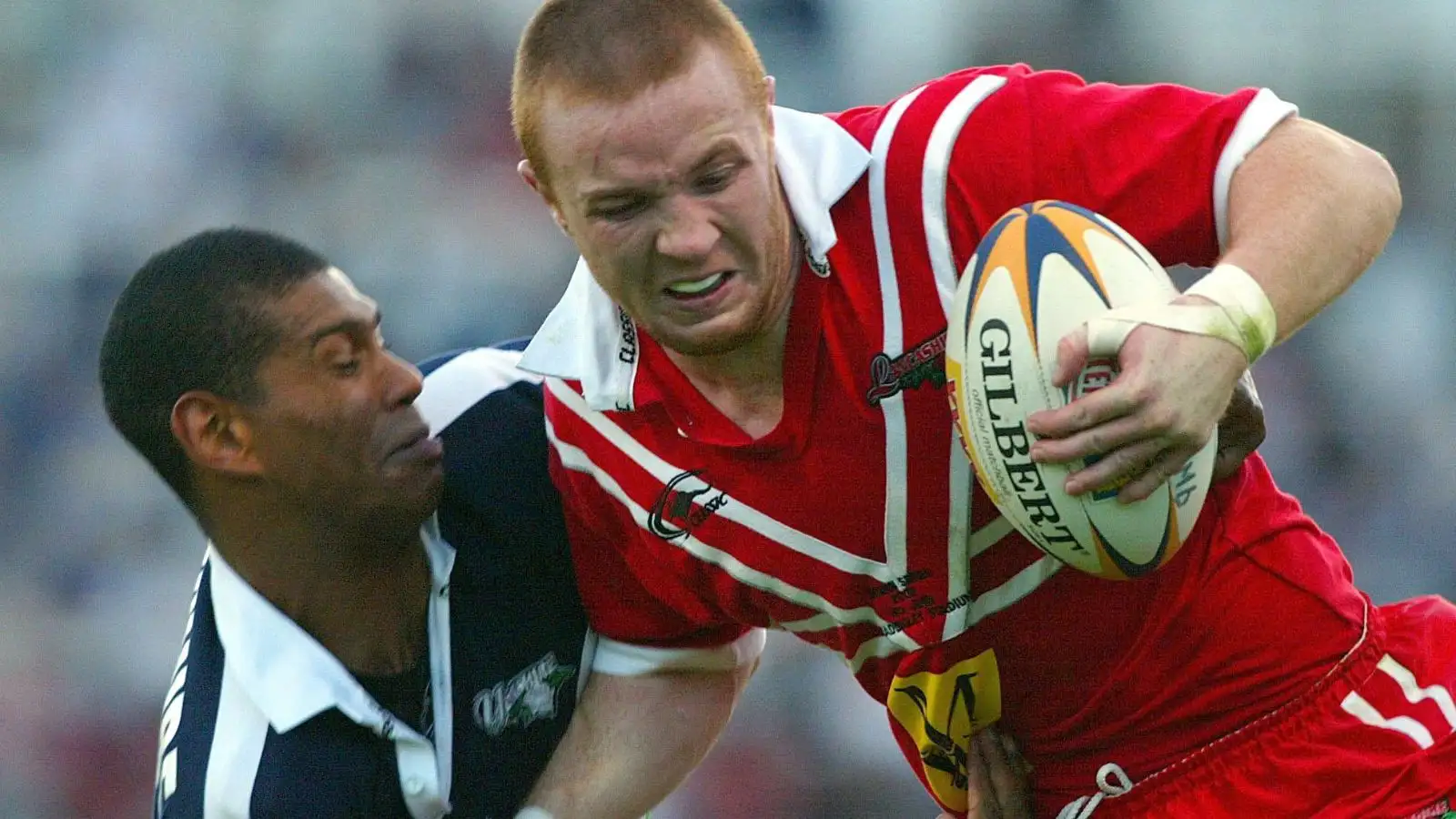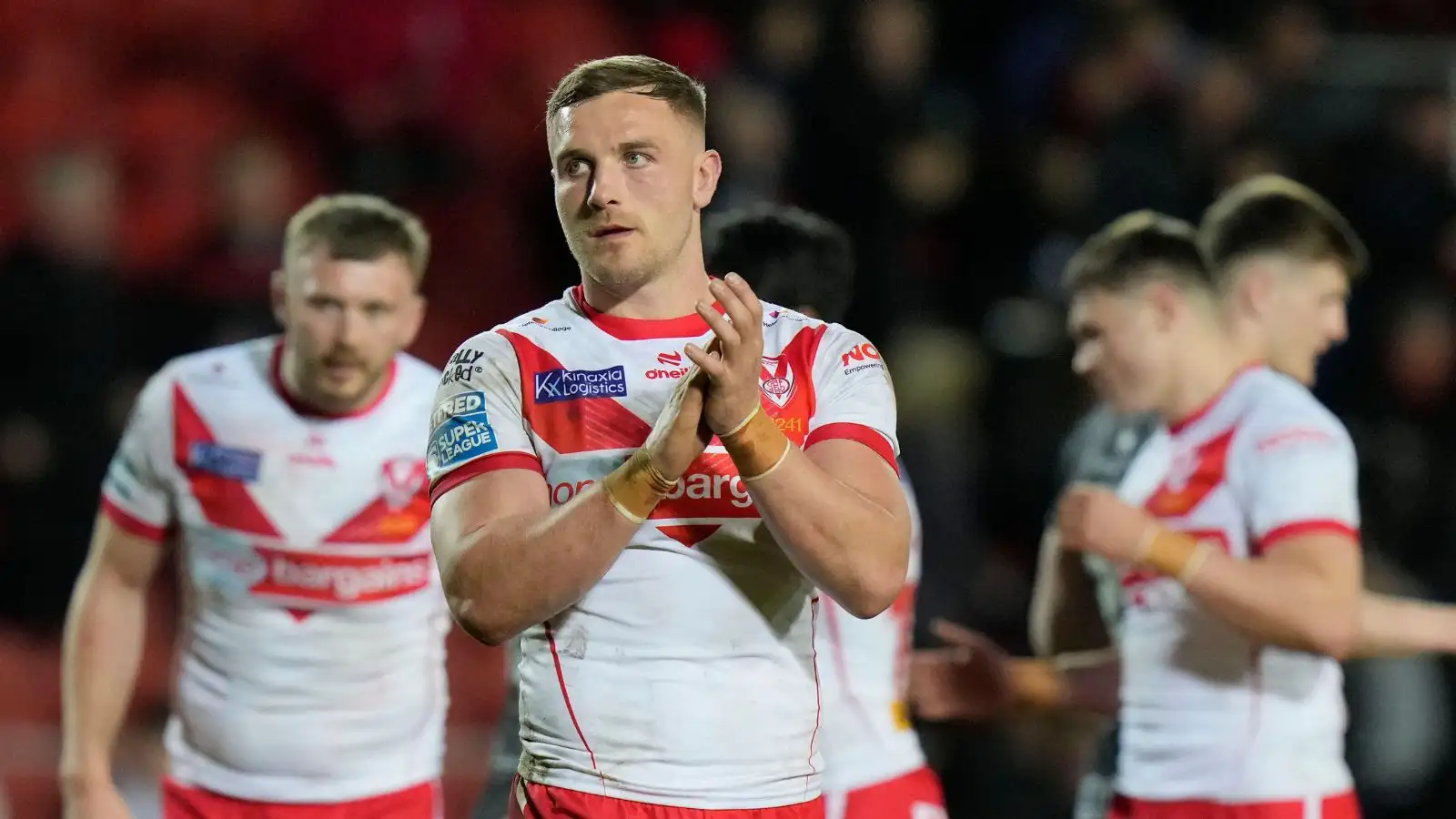British State of Origin failed – but should IMG revive it?

Photo: Martin Rickett/PA Archive/PA Images
The potential revival of the War of the Roses is a discussion we seemingly have in Britain every year whilst the State of Origin takes place in Australia…
40 years ago, the people running British rugby league looked at the County Championship fought between Lancashire, Yorkshire and Cumbria and decided that nobody was interested in watching it anymore.
It’s had origins stretched back to the birth of the game in 1895.
But in a deeply contested fixture schedule that consisted of the Lancashire and Yorkshire Cup, the JPS trophy, the Challenge Cup, the regular season, the end-of-season Premiership, and three month Kangaroo tours, it was seen as yesterday’s fixture. It had, in the words of The Times journalist Keith Macklin, become a “despised and moribund nuisance”.
Part of its problem was that players saw no reason to play in it.
Injuries were feigned and supporters would arrive at the ground to see that the programme – which listed the selected players – wasn’t worth the paper it was printed on.
As part of a drive to modernise the game it was finally axed in 1982 after just 732 people turned out to watch a match in Cumbria.
Few people mourned its loss.
A decade earlier, under the Local Government Act 1972, the southern parts of Lancashire became part of the new metropolitan counties of Merseyside and Greater Manchester.
In bringing it forward the Edward Heath government had argued that “the areas of many existing authorities are out-dated and no longer reflect the pattern of life and work in modern society”.
Australia success prompt spectacular U-turn
Events thousands of miles away in Australia would, however, prompt a spectacular U-turn.
In 1982, the year that the RFL ditched the County Championship, the idea of a three game series between NSW and Queensland was born.
And it wasn’t long before the RFL began to wonder if they hadn’t made a huge mistake.
As I outline in my forthcoming book, Hope and Glory: Rugby League in Thatcher’s Britain, the British game increasingly looked to Australia for inspiration in the 1980s.
The reality of league’s “managed decline”, culminating in the 1982 Kangaroo tour, shocked the British to their core.
To turn their fortunes around, players were told to match Australian fitness levels while Phil Larder revolutionised the coaching set-up.
When the chequebooks opened and the “gold rush” began, players such as Mal Meninga, Peter Sterling and Brett Kenny changed the very idea of what it meant to be a professional sportsman in Britain.
Australian culture began to influence the British way of life
 Photo: Australian Associated Press/Alamy Stock Photo
Photo: Australian Associated Press/Alamy Stock Photo
This was the beginning of the era of Fosters, Crocodile Dundee and Neighbours, where advertisers increasing tapped into the links between the two countries.
And technological changes made the Australian game more accessible to the ordinary British supporter.
Channel 4 started to show highlights from the Winfield Cup and clubs started ordering copies of Rugby League Week, which was available to read just 72 hours after it had hit newsstands in Sydney.
The rise of the video recorder opened up opportunities for supporters to access games like never before.
Companies such as Micron imported highlights and rented copies of matches to supporters, as film nights were held in pubs across the country.
When the Kangaroos returned to Britain in 1986, the anticipation was the highest it had ever been.
At Wigan, a record club crowd of over 30,000 people turned out while the First Test at Old Trafford broke the record attendance for an Ashes game.
A British State of Origin
Interest in the Australian game inevitably put the question of a British State of Origin back on the table.
In the entrepreneurial spirit of the age, Denis Roden, the chief of Rodstock – an amusement machine company in Wigan – put forward £10,000 to revive the “War of the Roses” concept and give the fixture the glamour and the profile it had always lacked.
In the 1970s, the ties would alternate between Widnes and Castleford. But the Rodstock series had much greater ambitions.
Central Park and Headingley were chosen as the major venues to host the game each year and Peter Fox and Alex Murphy were given the coaching jobs to drum up some media interest.
When more than 6,000 people turned up for the relaunched fixture in 1985 there was a feeling that it could develop into something bigger.
But it soon became apparent that something was missing.
It was framed as Great Britain trial. But everybody understood that the Great Britain team was not going to be impacted by the way in which players performed. Lancashire players often pulled out at short notice to focus on the domestic competition.
There was also a clear contradiction between the idea that it was a serious test match and the way that players approached it.
Yorkshire dominance
Yorkshire continually outperformed Lancashire in an era where Wigan, Widnes and St Helens dominated the domestic scene.
When Lancashire were defeated 56-12 in 1989 the players were accused of a “lack of stomach” for the contest.
“Of course, they were trying” argued Alex Murphy after one defeat. “It’s just that some of them were young lads overawed by the occasion”.
Yorkshire’s dominance – in contrast to the way that State of Origin thrived on Queensland’s – became the major concern.
By 1991 the organisers were running out of faith in the idea.
Desperate to shake things up, Lancashire appointed the unknown 29 year old Ray Ashton as coach. “I want people to play with pride and passion” he admitted. “I only want those who are prepared to go out and die for their county”.
Under Ashton, Lancashire put in their best performance of the revived series.
Writing in the Independent, Dave Hadfield concluded that it was “full of all the passion and uncertainty its five predecessors had lacked”.
Ambitions to move the game beyond the M62 corridor
Yet just as it was looking like Lancashire were closing the gap, the RFL axed it.
Paul Fitzpatrick summed up where the public mood was. “The ambition was to produce something to compare with Australia’s state of origin games” he wrote in the Guardian. “It has never acquired that stature and never will”.
The decision to axe the War of the Roses in 1992 chimed with the wider ambitions to move beyond the M62 corridor in the 1990s.
As Hope and Glory shows, there was an optimism within the game that the changes in the international game – and the revival of the Great Britain team – could turn rugby league into a truly global game.
London was seen as a growth area for the sport and the 1992 World Cup final at Wembley emphasised that there was an audience for the sport on a national level.
The repeated failure to convert such moments in to deep-rooted expansion inevitably led to calls to focus on the heartlands again.
The humiliation of the England side at the 2000 World Cup saw Great Britain appoint their first overseas coach, David Waite, as part of a nine-year plan to topple Australia.
This time the RFL was “serious” about developing the State of Origin concept ahead of the eagerly anticipated Ashes series. “In the past, players would just cry off” said Lancashire coach Andy Gregory. “But I will be expecting 100 per cent from these lads this time”.
Rebranded as The Origin Game
 Photo: Martin Rickett/PA Archive/PA Images
Photo: Martin Rickett/PA Archive/PA Images
Rebranded as “The Origin Game”, it was seen as a success when over 10,000 people turned up at Headingley. It was the biggest attendance for a county game since 1966 and led to the introduction of a two game series in 2002.
But it still did not have the intensity of the Australian version.
As Chris Irvine noted in The Times there was a danger that the public was being sold something that was impossible to attain.
“It had the air of a testimonial, rather than a meaningful preparation for Great Britain’s eagerly awaited encounter with Australia”.
When Great Britain then lost to Australia in Sydney by a record margin, questions were raised about whether it was really an adequate contest.
“Our forwards just steamrollered them,” said Andrew Johns in the aftermath. “I don’t think I need a shower.”
The following year the concept was quietly dropped after one final game at Odsal where Yorkshire again defied the bookmakers to come up with a 54-10 win.
Has its time come again?
Twenty years on, there is a growing belief that its time has come again.
Now we are under the guidance of the people at IMG, there have been several coaches, journalists and pundits who believe that it can be done better this time.
Speaking on the BBC 5 Live Rugby League Podcast, Jamie Jones-Buchanan said he would love to see the concept revived. Kevin Brown agreed that it would give Shaun Wane an opportunity to look at the players available to him.
WAR OF THE RSOES: Yorkshire v Lancashire return idea discussed by pundits
At the minute it is all just speculation.
But should IMG study the concept, the most difficult issue to square is whether there will be sufficient buy-in from people in the North West to support the idea of Lancashire.
One interesting solution was posed in 2010 by the Guardian journalist Andy Wilson, who has since become the Head of Media at the RFL. “Yorkshire against the Rest could be our State of Origin” he argued. Building the concept around Yorkshire pride mirrored the “Queensland-esque us-against-the-world mentality, and their corresponding unpopularity with everybody else.”
Or should it be left in the past?
Others have suggested that the revival of the ‘War of the Roses’ fails to address the sport as it really is in 2023.
Thinkers such as Andrew Foster have suggested that the RFL should tap into the growing Polynesian influence by turning the Combined Nations All-Star idea into a more prestigious fixture that can become unique within the sporting landscape.
If @TheRFL wanted to make @England_RL vs CNAS a showpiece occasion, what efforts have they made to do that?
Had a carefully planned and delivered build up, for a start.
1/6 pic.twitter.com/2Tm8gGuNC9
— Andrew Foster (@andrewfoster101) June 23, 2021
The questions now confronting IMG are the ones that have never been properly addressed by organisers.
What would the purpose of the War of the Roses be?
If it is a trial for potential England selection, would there be enough interest from supporters to sustain it and build it each season?
Would coaches ensure that players were made available?
Would players be motivated without the financial rewards that are available in Australia?
Would it attract a new sponsor that wasn’t already invested in the game?
The market suggests, as it has done since the 1980s, that the number of people interested in any mid-season international – whether it is France, British Origin, the Exiles or the All Stars – is between 6 and 10,000.
Do IMG have ambitions to move beyond that?
Would they be satisfied if the ‘War of the Roses’ achieved the same attendance as the England v France game at Warrington this year?
The debate around the revival of British State of Origin, in whatever format it takes place, throws up as many questions as it does solutions to the games problems.
And if the ‘War of the Roses’ is to become a permanent fixture in the rugby league calendar, it will need something that we have never been able to implement before: a long term strategy for growth.
Anthony Broxton’s book Hope and Glory: Rugby League in Thatcher’s Britain will be published later this year and is available to pre-order now.
READ NEXT: Featherstone still knocking on the door 40 years on from their unlikely Wembley triumph



